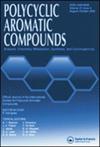Functionalized 2-Amino-4H-1-Benzopyran-4-yl Phosphonate Scaffolds: Synthesis, Anticancer Evaluation and Computational Studies
IF 2.6
3区 化学
Q2 CHEMISTRY, ORGANIC
引用次数: 0
Abstract
Prostate, breast, and lung cancers are various human cancers that have been associated with SRC kinase mutations. Therefore, the development of potent and selective SRC kinase inhibitors is an exciting area of interest for researchers. In this study, we synthesized a series of 2-amino-4H-1-benzopyran-4-yl phosphonate derivatives through a one-pot reaction involving appropriately substituted salicylaldehydes, malononitrile, and diethyl phosphite, with meglumine as the catalyst. We conducted in vitro screening of these compounds for their anticancer activity against human prostate cancer (DU-145), breast cancer (MCF-7), and lung cancer (A549) cell lines using the MTT assay. Notably, compounds 4a, 4j, 4k, and 4l exhibited promising anticancer activity. Molecular docking studies of these compounds supported their potential as therapeutic agents for SRC kinase inhibition. Specifically, compounds 4a, 4b, 4c, 4d, and 4e demonstrated strong ΔG binding affinities ranging from −7.9 to −7.4 kcal/mol. These findings suggest that these molecules hold promise for cancer treatment.
功能化2-氨基- 4h -1-苯并吡喃-4-酰基膦酸酯支架:合成、抗癌评价和计算研究
前列腺癌、乳腺癌和肺癌是各种与SRC激酶突变相关的人类癌症。因此,开发有效的、选择性的SRC激酶抑制剂是一个令人兴奋的研究方向。
本文章由计算机程序翻译,如有差异,请以英文原文为准。
求助全文
约1分钟内获得全文
求助全文
来源期刊

Polycyclic Aromatic Compounds
化学-有机化学
CiteScore
3.70
自引率
20.80%
发文量
412
审稿时长
3 months
期刊介绍:
The purpose of Polycyclic Aromatic Compounds is to provide an international and interdisciplinary forum for all aspects of research related to polycyclic aromatic compounds (PAC). Topics range from fundamental research in chemistry (including synthetic and theoretical chemistry) and physics (including astrophysics), as well as thermodynamics, spectroscopy, analytical methods, and biology to applied studies in environmental science, biochemistry, toxicology, and industry. Polycyclic Aromatic Compounds has an outstanding Editorial Board and offers a rapid and efficient peer review process, as well as a flexible open access policy.
 求助内容:
求助内容: 应助结果提醒方式:
应助结果提醒方式:


